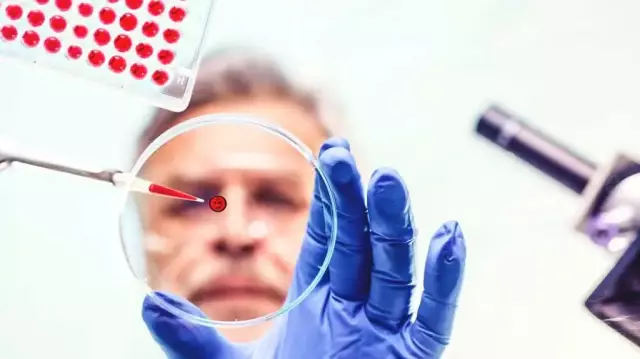- Author Rachel Wainwright [email protected].
- Public 2023-12-15 07:39.
- Last modified 2025-11-02 20:14.
Hyperaldosteronism
The content of the article:
- Causes
- Forms
- Signs
- Features of the course in children
- Diagnostics
- Treatment
- Prevention
- Consequences and complications
Hyperaldosteronism is a pathological syndrome in which excessive production of aldosterone is diagnosed by the glomerular zone of the adrenal cortex.
Aldosterone is a mineralocorticosteroid, a hormone responsible for maintaining the sodium-potassium balance in the body. Its increased secretion leads to metabolic disorders.
In women, primary hyperaldosteronism is recorded 3 times more often, manifestation occurs after 30 years.

Primary hyperaldosteronism is characterized by low levels of renin and potassium, hypersecretion of aldosterone, and high blood pressure
Causes
Most often, primary hyperaldosteronism is observed in the following pathological conditions:
- benign and malignant tumors of the adrenal glands (primarily adenoma of the adrenal cortex);
- hyperplasia of the adrenal cortex.
Secondary hyperaldosteronism develops against the background of:
- excessive intake of potassium;
- increased sodium loss;
- hypersecretion of renin;
- a sharp decrease in the volume of circulating fluid;
- pregnancy;
- redistribution of extracellular fluid, which leads to a decrease in the filling of large vessels with blood.
Forms
There are two main forms of the syndrome:
- Primary hyperaldosteronism (excess production of aldosterone is associated with increased activity of the cellular structures of the glomerular adrenal cortex).
- Secondary hyperaldosteronism (excessive secretion of aldosterone is provoked by disorders in other organs).

Hyperaldosteronism may be associated with disorders of the adrenal glands themselves or other organs
Primary hyperaldosteronism, in turn, is of the following forms:
- idiopathic hyperaldosteronism (IHA) - bilateral diffuse hyperplasia of the glomerular zone;
- aldosteroma (aldosterone-producing adenoma, APA, Conn's syndrome);
- primary unilateral adrenal hyperplasia;
- aldosterone-producing carcinoma;
- familial type I hyperaldosteronism (glucocorticoid-suppressed);
- familial type II hyperaldosteronism (glucocorticoid-unsuppressed);
- aldosteronectopic syndrome with extra-adrenal localization of aldosterone-producing tumors (in the ovary, thyroid gland, intestines).
There is also pseudoaldosteronism - a condition when the main clinical symptoms of hyperaldosteronism (high blood pressure, hypokalemia) are detected against the background of a decrease in the concentration of aldosterone in the blood plasma.
Signs
Primary hyperaldosteronism is characterized by:
- hypertension (increased blood pressure), accompanied by headache of varying intensity;
- hypokalemia (clinically manifested by increased fatigue, muscle weakness, convulsions);
- lesions of the vessels of the fundus;
- polyuria (constant feeling of thirst, frequent urge to empty the bladder at night, decreased urine density);
- psychoemotional disorders (asthenia, hypochondria, anxious readiness, depression).

High blood pressure is a common symptom of hyperaldosteronism
The most common clinical manifestations of secondary hyperaldosteronism, in addition to the symptoms of the underlying pathology, are:
- increased blood pressure;
- alkalosis;
- decrease in the level of potassium in the blood plasma.
Features of the course in children
In children, hyperaldosteronism manifests itself in the form of Liddle's syndrome, which manifests itself in the first 5 years of a child's life. It is characterized by:
- severe dehydration;
- increasing hypertension;
- lag in physical and psycho-emotional development.
Diagnostics
A routine method to identify patients at risk is to measure blood pressure. Its increased values are an indication for a screening examination (determination of the concentration of potassium in the blood plasma). A decrease in the concentration of potassium in the blood less than 2.7 meq / l suggests further examination to clarify the clinical diagnosis.
The main diagnostic method for this syndrome is the determination of the level of aldosterone in the blood plasma and the detection of increased daily excretion of its metabolite (aldosterone-18-glucuronide) in the urine.

To diagnose hyperaldosteronism, blood is examined to determine the level of aldosterone
Additionally, the following visualization methods are used:
- ultrasound scanning of the adrenal glands;
- adrenal scintigraphy;
- computed or magnetic resonance imaging of the adrenal glands.
Genetic diagnosis reveals pseudohyperaldosteronism and familial forms of the primary disease.
Treatment
Therapeutic tactics depend on the form of the disease.
Primary hyperaldosteronism against the background of aldosteroma or bilateral hyperplasia of the adrenal parenchyma involves surgical correction and restoration of the level of potassium in the body by taking potassium preparations and potassium-sparing diuretics.
In idiopathic form, appoint:
- angiotensin-converting enzyme inhibitors;
- aldosterone antagonists;
- potassium-sparing diuretics;
- calcium channel blockers.
Liddle's syndrome is an indication for kidney transplantation.

If the cause of hyperaldosteronism is Liddle syndrome, kidney transplantation is indicated
Treatment of secondary hyperaldosteronism consists in pathogenetic and symptomatic therapy of the underlying disease.
The criteria for determining the effectiveness of the therapy for hyperaldosteronism are:
- normal blood pressure;
- stabilization of potassium levels in the blood;
- reaching the age-appropriate concentration of aldosterone in the blood.
Prevention
Dispensary observation of patients with high blood pressure makes it possible to detect hyperaldosteronism in the early stages and correct it in a timely manner.
Consequences and complications
An overdose of drugs that block the synthesis of adrenal steroid hormones can cause adrenal insufficiency.
The information is generalized and provided for informational purposes only. At the first sign of illness, see your doctor. Self-medication is hazardous to health!






